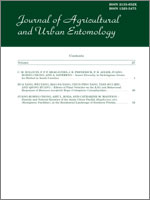The cancellation of most organophosphate and carbamate insecticides, and the emerging resistance to currently available insecticides for managing the lesser mealworm, Alphitobius diaperinus (Panzer) (Coleoptera: Tenebrionidae), necessitate efficacy studies on other classes of insecticidal compounds. Baseline dose-response bioassays were conducted with three different types of insect growth regulators (IGRs), fenoxycarb, diflubenzuron, and 20-hydroxyecdysone (20E) on first and seventh instars, two day-old pupae, and one-week-old adult beetles. Insects were exposed to a range of concentrations through topical application, by residual contact with treated wood shavings, and through feeding on treated chicken feed diet. Insects were observed at 10-day intervals to estimate mortality, pupation, and abnormal growth for each treatment. The mean number of days to pupation increased and pupation was delayed in fenoxycarb-treated seventh instars in feeding, residual, and topical bioassays. Fenoxycarb-treated larvae continued to molt and gain weight, and died as deformed larvae, abnormal pupae, or intermediate larval-pupal and pupal-adult forms. In feeding bioassays, fenoxycarb was more toxic to seventh instars than to first instars or adults, whereas diflubenzuron was more toxic to first instars than it was to seventh instars or adults. The feeding bioassay was more suitable for the first and seventh instars, although the residual contact bioassay could also be used for seventh instars. Adults succumbed to lower concentrations of IGRs in a topical bioassay than in feeding or residual bioassays. All three bioassay methods produced usable dose-response curves and may be used for surveying temporal changes in the IGR susceptibility to lesser mealworm.
BioOne.org will be down briefly for maintenance on 17 December 2024 between 18:00-22:00 Pacific Time US. We apologize for any inconvenience.
How to translate text using browser tools
1 January 2013
Baseline Responses of Alphitobius diaperinus (Coleoptera: Tenebrionidae) to Insect Growth Regulators
N. Singh,
D. T. Johnson
ACCESS THE FULL ARTICLE
It is not available for individual sale.
This article is only available to subscribers.
It is not available for individual sale.
It is not available for individual sale.
Alphitobius diaperinus
Coleoptera
feeding bioassay
pupation
susceptibility
Tenebrionidae
weight gain





